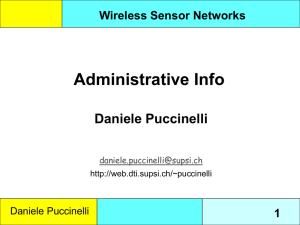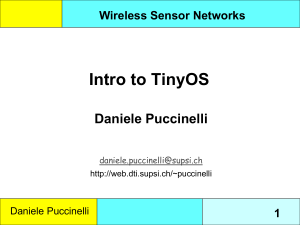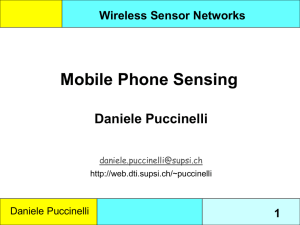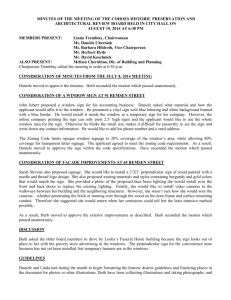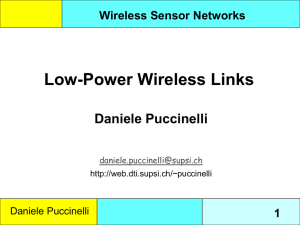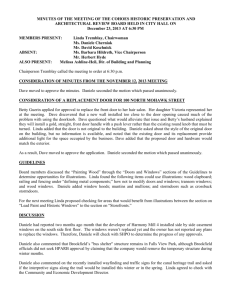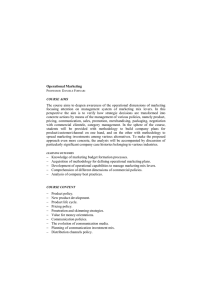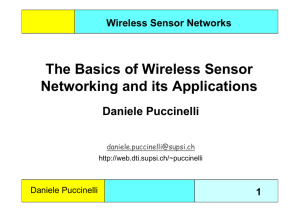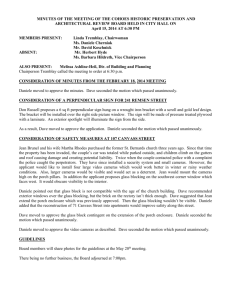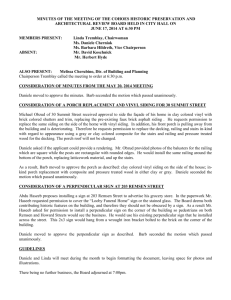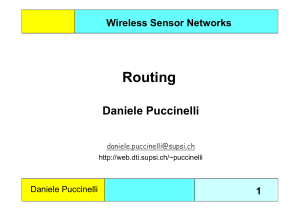Medium Access Control Daniele Puccinelli Wireless Sensor Networks 1
advertisement
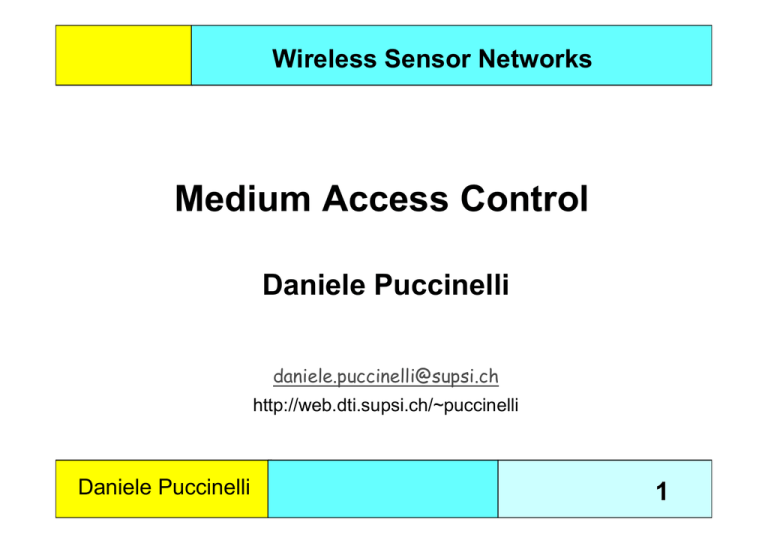
Wireless Sensor Networks Medium Access Control Daniele Puccinelli daniele.puccinelli@supsi.ch http://web.dti.supsi.ch/~puccinelli Daniele Puccinelli 1 MAC protocols MAC = Medium Access Control I want to talk to B... ...over a shared medium A B B A wants to drive to B A but there is traffic on the road: need to avoid collisions Daniele Puccinelli 2 WSN: MAC and Connectivity There’s more to WSN MACs than managing contention • In WSNs, contention is a relatively small problem (low load) • Overhearing and idle listening are huge problems that are closely related • MAC-layer duty-cycling to be enforced as a baseline solution There’s no such thing as static connectivity • Do not underestimate the temporal dynamics of wireless links • You typically have little control over such dynamics • The connectivity that you measure today is not (necessarily) what you will see tomorrow Daniele Puccinelli 3 Dealing with Lousy Links Reception does not imply link existence • Links are not Boolean • Packets may very well arrive over ultra-poor links...but you can’t count on it • Links must be estimated with as little overhead as possible Asymmetric links are a very common problem • There exists a transitional connectivity region where the PDR changes wildly • Transitional links may be asymmetric • Even high RSS links may be asymmetric due to interference Link-layer retransmissions are fundamental • They enable correct link quality estimation that benefits routing Daniele Puccinelli 4 MAC protocols for WSNs • Low-power operation • Channel utilization efficiency • Flexibility (configurable by upper layers) • Scalability (many nodes) • Robustness (RF propagation effects) • Simplicity (must run on resource-constrained CPU) and, like any other MAC, • Collision avoidance Daniele Puccinelli 5 Major sources of energy waste • Collisions Retransmissions required (more latency) • Overhearing Same cost as receiving • Control overhead Control packets also have a cost (e.g., RTS/CTS) • Idle listening Almost as costly as receiving Daniele Puccinelli 6 Collisions Hidden Node Problem A B C A wants to transmit to B...who is receiving from C Daniele Puccinelli 7 Collisions A B C Daniele Puccinelli 8 Collisions A B C A cannot hear C...and A’s and C’s packet collide at B Daniele Puccinelli 9 Overhearing I’m not C F B I’m not C I’m not C Here’s a packet for C! E H A That’s me! C G D Daniele Puccinelli 10 Control Overhead In legacy wireless, collisions are addressed with RTS/CTS I want to talk to B A Daniele Puccinelli B C Ready To Send to B 11 Control Overhead In legacy wireless, collisions are addressed with RTS/CTS A Daniele Puccinelli B C:You’re Clear To Send C 12 Control Overhead RTS/CTS avoids collisions at the cost of a control overhead A I guess B is busy right now B C:You’re Clear To Send C The extra control packets have a significant energy cost Daniele Puccinelli 13 Idle Listening The power consumption of short range (low-power) wireless devices is roughly the same (same order of magniture) whether the radio is transmitting, receiving, or idle Radio must be on idle to receive anything Most applications employ infrequent transmissions Idle listening dominates energy consumption... ...unless duty-cycling is adopted Two flavors of duty-cycling: • at the MAC layer (works across different applications) • application-informed (specific to one application) Daniele Puccinelli 14 Idle Listening and Overhearing Idle Listening Your radio is on and ready to go Whatever gets transmitted is received by your radio (physically, everything is broadcast!) Overhearing You receive a transmission meant for another node Your MCU discards it, but your radio receives it Idle Listening results in Overhearing Daniele Puccinelli 15 The Cost of Medium Sampling • Depends on the radio • Constant across different protocols • Example for the CC1000 (80µJ) (a) (g) Radio is asleep (b) Radio wakeup and init (c) The oscillator stabilizes 25 µJ 10 µJ 20 µJ 10 µJ (d) Radio enters RX mode 15 µJ (e) The medium gets sampled (f) ADC conversion Daniele Puccinelli Versatile Low Power Media Access for Wireless Sensor Networks J. Polastre, J. Hill, and D. Culler, SenSys’08 16 Basic WSN MAC Techniques Coordinated synchronized slotted scheduling • Arrange a schedule of communication opportunities • Maintain coordinated clocks and schedule • Listen during specific slots • Examples: S-MAC, T-MAC Sampled Listening • Listen for very short intervals to detect transmissions • On detection, listen actively to receive • Examples: LPL, BMAC, XMAC • Maintain always on illusion Daniele Puccinelli 17 TDMA basic scheme TDMA = Time Division Media Access • Each node has a schedule of awake times • Typically used in star around coordinator • Bluetooth, ZigBee • Coordinator hands out slots • Far more difficult with multi-hop networks • Further complicated by network dynamics Daniele Puccinelli 18 CSMA basic scheme CSMA = Carrier Sense Multiple Access • • • • Sense the medium If busy, back off If free, talk right away (1-persistent CSMA)... ...or pick a future time slot when you get to talk (non-persistent CSMA) Non-persistent CSMA is the standard solution Daniele Puccinelli 19 MACs for WSN • WSN MAC is one of the key research areas • A smart MAC can save tons of energy • • • • • S-MAC: seminal work BMAC: most influential design Optimizations: WISEMAC, X-MAC Building blocks: LPL, SIFT Special solutions: Wake-Up Radio (STEM) • Check out the MAC Alphabet Soup at: http://www.st.ewi.tudelft.nl/~koen/MACsoup/index.php Daniele Puccinelli 20 S-MAC • A MAC scheme targeted at WSNs • Use RTS/CTS while duty-cycling the nodes • Fairness is not so important in WSNs o In regular wireless networks, each user deserves an equal share of medium access o In WSNs, typically: all nodes cooperate toward the same goal a node may have a lot more data to send than everyone else S-MAC solution: if you have more data, you get a bigger share • Latency is not so important in many applications S-MAC solution: nodes put their radios to sleep for part for the time An Energy-Efficient MAC Protocol for Wireless Sensor Networks W. Ye, J. Heidemann, and D. Estrin, INFOCOM’02 Daniele Puccinelli 21 Fairness in WSNs Sample application: toxic plume detection wireless medium Daniele Puccinelli Fairness is not important: the node with the plume info MUST get priority 22 More on S-MAC • Nodes set up schedules (sleep/activity) • Schedules are exchanged • Medium contention (RTS/CTS) only within activity periods • RTS/CTS reserves medium for a whole message (unfair) • Overhearing avoidance: extra-sleep if you get RTS or CTS • Nodes need to be synchronized • Control overhead is significant: sync and RTS/CTS • Poor scalability properties (schedules require memory space) Daniele Puccinelli 23 Addressing all sources of inefficiency S-MAC tries to reduce energy waste from all four sources of energy inefficiency • • • • Collision – with RTS and CTS Overhearing – by duty-cycling the radio Control overhead – with message passing (messages get broken down into small packets and sent as a burst) • Idle listening – with periodic listen and sleep Daniele Puccinelli 24 CMPE280n Duty-Cycling • WSN Problem: Idle listening uses up tons of energy • S-MAC Solution: Periodic listen and sleep • Benefit: much lower energy consumption • Drawbacks: more latency less fairness Latency and Fairness are a small price to pay MAC-level Duty Cycling is now a standard technique Daniele Puccinelli 25 Collision Avoidance WSN Problem: Multiple senders want to talk together Options: Contention vs. TDMA S-MAC Solution: Similar to IEEE 802.11 ad hoc mode (DCF) Physical and virtual carrier sense Randomized back-off time RTS/CTS for hidden terminal problem RTS/CTS/DATA/ACK sequence Daniele Puccinelli 26 Overhearing Avoidance WSN Problem: You receive packets destined to others S-MAC Solution: Sleep when neighbors talk Who should sleep? • All immediate neighbors of sender and receiver How long to sleep? • The duration field in each packet informs other nodes the sleep interval Synchronization is needed, but not as tight as TDMA Daniele Puccinelli 27 Performance Evaluation Average energy consumption in the source nodes Source 1 1800 Sink 1 802.11-like protocol Overhearing avoidance S-MAC Source 2 Sink 2 • Each source node sends 10 messages • Each message has 400B in 10 fragments • Measure total energy over time to send all messages Daniele Puccinelli Energy consumption (mJ) 1600 1400 1200 1000 800 600 400 200 0 2 4 6 8 10 Message inter-arrival period (second) An Energy-Efficient MAC Protocol for Wireless Sensor Networks W. Ye, J. Heidemann, and D. Estrin, INFOCOM’02 28 B-MAC • Uses CSMA/CA • Radio duty-cycling: Low Power Listening • Packets can be individually acknowledged • No schedule exchange (less control overhead) • Channel is sampled periodically for activity o Preamble matched to sampling interval to ensure activity detection o Rx cost is reduced, but Tx cost is increased o False positives mess up the duty-cycling • Puts simplicity first to ensure a small footprint • Modular and tunable Daniele Puccinelli 29 B-MAC’s long preamble concept Low Power Listening (LPL) is the centerpiece of B-MAC activity detected sampling interval reception! RX activity not detected long preamble payload TX • B-MAC shifts the energy burden from the RX to the TX Daniele Puccinelli 30 Duty-Cycle vs. Neighborhood Size Versatile Low Power Media Access for Wireless Sensor Networks J. Polastre, J. Hill, and D. Culler, SenSys’04 Daniele Puccinelli 31 BMAC Sleep Time Settings Versatile Low Power Media Access for Wireless Sensor Networks J. Polastre, J. Hill, and D. Culler, SenSys’04 Daniele Puccinelli 32 X-MAC • A long preamble means too much latency • A strobed preamble allows the receiver to cut the preamble short X-MAC: a short preamble MAC protocol for dutycycled wireless sensor networks M. Buettner et al., SenSys’06 Daniele Puccinelli 33 WISEMAC • Keep track of your neighbors Achieve a coarse synchronization to them • Avoid a long preamble for frequent traffic exchanges Preamble Length is proportional to Inter-Packet Interval Longer preambles for infrequent traffic • Timing information gets piggy-backed on packets Preambles start out long and get shorter as more packets are exchanged • A shorter preamble saves energy at the tx as well as at the overhearing nodes • Only works for unicast (broadcast must reach everyone) Daniele Puccinelli 34 Collisions Collisions are natural with random access When a collision occurs, node back off Standard Approach: Binary Exponential Backoff • When a collision first occurs, pick a slot in your Contention Window (CW) uniformly at random o CW = bunch of slots o Slot = opportunity for a node to start transmitting • In your slot, sense the medium and back off if it’s busy • Each time a collision reoccurs, double the CW • You win if you catch the earliest slot Daniele Puccinelli 35 CSMA and Event-Driven WSNs In event-driven sensor networks: • Collisions are spatially correlated • Traffic is bursty • The number of competing senders changes rapidly With a uniformly random slot choice, scalability is poor With more than 15 contending senders and 32 slots, the probability of success drops dramatically Increasing the CW is a waste of time! Daniele Puccinelli 36 SIFT A building block for the MAC layer of event-driven WSNs • With a uniform distribution for slot choice, any node can pick any slot in the CW with the same probability • Use a skewed distribution that makes it more likely for nodes to choose later slots Benefit: only a few nodes will pick the early slots Up to a 7-fold latency reduction compared to standard CSMA Sift: A MAC Protocol for Event-Driven Wireless Sensor Networks, K. Jamieson, H. Balakrishnan, and Y. Tay, EWSN’06 Daniele Puccinelli 37 The Wake Up Radio Concept Use an ultra-cheap radio to wake up your low-power radio Pioneered by the PicoRadio Project Susceptible to noise (false alarms) The ultra-cheap wake-up radio can’t reach as far as the transfer radio STEM (Sparse Topology and Energy Management), Schurgers et al., 2002 Your wake-up radio needs not be ultra-cheap...just run it wisely Decouple wake-up from transfer: one radio turns on the link (on-demand continuous polling) another radio uses the link rationale: continuous polling hurts ongoing data transfers Same radio at different frequencies? no concurrent transfer and wake-up Daniele Puccinelli 38 802.15.4 MAC • Contention-based (with optional priority) • Hierarchical • Nodes can be coordinators or devices • One coordinator is elected as PAN coordinator • Coordinators are in charge, devices comply • FFDs (Full Function Devices) can be either • RFDs (Reduced Function Devices) are devices • Two possible communication patterns: star and peer-to-peer • Two modes: beaconed and non-beaconed Daniele Puccinelli 39 802.15.4 Basic Topology • Devices can only obey • They cannot talk to each other • They comply with the instructions of a coordinator device PAN coordinator Daniele Puccinelli 40 802.15.4 generalized topology • Coordinators can talk to each other (peer-to-peer) PAN coordinator device coordinator Daniele Puccinelli 41 802.15.4 MAC Beaconed Mode beacon active period beacon inactive period time Contention Access Period Guaranteed Timeslots • Active/inactive for duty-cycling of coordinators • Contention Access Period: slotted CSMA/CA, backoff in [0, (2^B)-1]t B=Backoff Exponent: starts out at 1, incremented at each failed access • Guaranteed Timeslots: TDMA medium access • Beacons for management (sync, association, timeslot assignment) Daniele Puccinelli 42 802.15.4 Non-Beaconed Mode • Coordinators always on (no duty-cycling for the boss) • Unslotted CSMA for devices • Data/ack handshake Here’s my data Can I send data? Got it! Sure! • MAC immediately acknowledges received packets Daniele Puccinelli 43 Reading List 1. W. Ye, J. Heidemann, and D. Estrin", An Energy-Efficient MAC protocol for Wireless Sensor Networks, INFOCOM’02 (S-MAC paper) 2. J. Polastre, D. Culler, "Versatile Low Power Media Access for Wireless Sensor Networks", SenSys'04 (BMAC paper) Daniele Puccinelli 44
